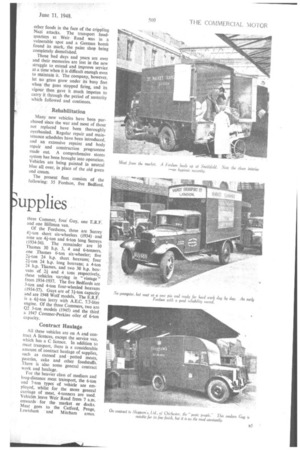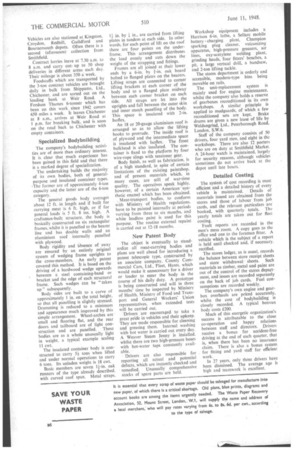What Lies Behind London's Mea
Page 38

Page 39

Page 40

If you've noticed an error in this article please click here to report it so we can fix it.
upplies
THE story of Market Transport, Ltd., 166, Weir Road, London, S.W.12, a company which has been transporting meat and other foodstuffs since 1921, is one of conscientious specialization, and of the gradual perfection of detail function and organization.
The family name of Tapp has been synonymous with that of the company from its earliest days, Mr. P. J. R. Tapp, C.B.E., M.C., M.Inst.T.—a parttime member of the Road Transport Executive, and founder and chairman of the Meat Transport Organization— started the business in partnership with his brother, Mr, E. T. J. Tapp, M.B.E., M.1.Mech.E., well known as an engineer The former is present chairman of the company and the latter is a director, whilst Mr. Raymond P. J. Tapp, son of " P.J.R.," is director and secretary.
Operation of the fleet of 50 vehicles is mainly in London and the Home Counties. Before the war there was a London-Southampton service, but this was dropped when the company began to concentrate on meat haulage, which originates at Smithfield Market and the London docks. The Meat Transport Pool was formed in 1939 and " P.J.R." was intensively occupied with this organization for some years. His son •was in the Army, and Mr. S. Hollister, A.M.Inst.T., now a director, was actively engaged in the operation of the company, together with Mr. A. F. Legg.
Fleet strength during the war was about 45, and the excellent unavailability figure of 7 per cent, was recorded. Vehicles, in their dark green war paint, were maintaining without failure the distribution of meat and
other foods in the face of the crippling Nazi attacks. The transport headquarters at Weir Road was in a vulnerable spot and a German bomb found its mark, the paint shop being completely demolished.
Those bad days and years are over and their memories are lost in the new struggle to extend and improve service at a time when it is difficult enough even to maintain it. The company, however, let no grass grow under its busy feet when the guns stopped firing, and its vigour then gave it much impetus to carry it through the period of austerity which followed and continues.
• Rehabilitation
Many new vehicles have been purchased since the war and most of those not replaced have been thoroughly oyerhauled. Regular repair and maintenance schedules have been introduced, and an extensive repaint and body repair and construction programme made out. A comprehensive stores system has been brought into operation. Vehicles are being painted in neutral blue all over, in place of the old green and cream.
The present fleet consists of the following: 35 Fordson, five Bedford,
three Contract, four. Guy, one E.R.F. and one Hillman van.
Of the Fordsons, three are Surrey 4i-ton short six-wheelers (1934) • and nine are 4i-ton and 6-ton long Surreys (1934-36). The remainder are 10 Thames 30 h.p. 3, 4 and 6-tonners, one Thames 6-ton six-wheeler; five 21-ton 24 h.p. short boxvans; four 21-ton 24 h.p. long boxvans; a 4-ton 24 h.p. Thames, and two 30 h.p. boxvans of 2i and 4 tons respectively, these vehicles varying in " vintage " from 1934-1937. The five Bedfords are 3-ton and 4-ton four-wheeled boxvans (1934-37). Guys are of 3i-ton capacity and are 1948 Wolf models. The E.R.F. is a61-ton lorry with A.E.C. 7.7-litre engine. Of the three Commers, two are Q2 3-ton models (1945) and the third a 1947 Commer-Perkins oiler of 6-ton capacity.
Contract Haulage
All these vehicles are on A and contract A licences, except the service van, which has a C licence. In addition to meat transport, there is a considerable amount of contract haulage of supplies, such as canned and potted meats, pastries, cake and other foodstuffs. There is also some general contract work and haulage.
For the heavier class of medium and long-distance meat transport, the 6-ton and 7-ton types of vehicle are employed, whilst for the more general carriage of meat, 4-tonners are used. Vehiclris leave Weir Road from 7 a.m. onwards% for the market or docks. Meat 'goes to the Catford, Penge, Lewisham and Mitcham areas.
Vehicles are also stationed at Kingston. Croydon, Redhill, Guildford and Bournemouth depots. Often there is a second (afternoon) collection from Smithfield.
Contract lorries leave at 7.30 a.m. to 8 a.m. and carry out. up to 50 shop deliveries in different areas each day. Their mileage is about 350 a week.
Foodstuffs which are transported by the 3-ton contract vehicles are brought daily in bulk from Shippams, Ltd., Chichester, and are sorted out on the loading bank at Weir Road. A Fordson Thames 6-tonner which has been on this work since 1942 covers 650 miles a week, it leaves Chichester at 8 a.m., arrives at Weir Road at 1 p.m. for breaking bulk, and is soon on the road back to Chichester with empty containers.
Specialized Bodybuilding
The company's bodybuilding activities are of more than ordinary interest. It is clear that much experience has been gained in this field and that there is a marked degree of specialization.
The undertaking builds the majority of its own bodies, both of generalpurpose and insulated container types. -The former are of approximately 4-ton capacity and the latter are of the 6-ton category.
The general goods body averages about 12 ft. in length and if built for carrying meat is 6 ft. high, or if for general loads is 5 ft. 8 ins. high. A craftsman-built structure, the body is basically constructed on six rectangular frames, whilst it is panelled to the bearer line and has double walls and an aluminium roof internally panelled with plywood.
Body rigidity and 'absence of sway are ensured by an entirely original system of wedging frame uprights to the cross-members. An early patent covered this method. It is based on the driving of a hardwood wedge upwards between a steel containing-band or bracket and the edge of each structural frame. Such wedges can be "taken up" subsequently.
Body sides are built to a curve of approximately 1 in. on the total height, so that all panelling is slightly stressed. Drumming is reduced to a minimum and appearance much improved by this simple arrangement. Wheel-arches are small and flooring flat, and the rear doors and tailboard are of light construction and are panelled. These bodies are as a whole unusually light in weight, a typical example scaling 11 cwt.
The insulated container body is constructed to carry 5i tons when lifted and under normal operations to carry 6 tons. Its unladen weight is 18 cwt.
Basic members are seven 1f-in, oak runners of the type already described. with curved roof span. Metal straps. 11. in. by k in., are carried from lifting plates in tandem at each side. In other words, for each point of lift on the roof there are four points on the underframe. This arrangement distributes the load evenly and cuts down the weight of the strapping and fittings.
Frames are all joined at their lower ends by a 6-in, by i-in. oak board bolted to flanged plates on the bearers. Lifting straps are connected to corner lifting brackets at each corner of the body and to a flanged plate midway between each corner bracket on each side. All straps are let into the uprights and fall between the outer skin and inner match panelling of the body. This space is insulated with 2-in. Isoflex.
An 18 or 20-gauge aluminium roof is arranged so as to allow the lifting hooks to protrude. The inside roof is of plywood and the intermediate space is insulated with Isoflex. The front bulkhead is also insulated. The container is fixed to the platform by four wire-rope slings with tensioner gear. Body finish, as well as fabrication, is of a high standard, in spite of certain limitations of the existing paintshop. and of present materials which, in many cases, are still of war-time quality. The operatives speak highly. however, of a certain American syn. thetic enamel which has been obtained. . Meat-transport bodies, to conform with Ministry of Health regulations. have to be painted internally at periods varying from three to six months, and white leadless paint is used for this purpose. The routine external repaint is carried out at 12-18 months.
New Patent Body
The object is eventually to standardize all meat-carrying bodies and plans are well ahead for introducing a patent telescopic type, constructed by an associate company. County Commercial Cars, Ltd., Fleet. Hants, which would make it unnecessary for a driver or loader to enter the body in the course of his daily duty. A prototype is being constructed and will in three months' time be inspected by Ministry of Health, Ministry of Food and Transport and General Workers' Union representatives, when extended tests will be carried out.
Drivers are encouraged to take a great pride in vehicles and their upkeep. They are made responsible for cleaning and greasing them. Internal washing with hot water is carried out every day. A Weaver Steam Jenny is installed. whilst there are two high-pressure hoses with hot-water taps constantly available.
Drivers are also responsible for reporting all actual and potential defects, which are instantly checked and • remedied. Unusually comprehensive stocks of spare parts are held. Workshop equipment includes a Harrison 6-in, lathe, a Sellarc mobile battery charging plant, Champion sparking plug cleaner, vulcanizing apparatus, high-pressure greasers, air lines, oxy-acetylene welding plant, grinding heads, four fitters' benches, a pit, a large vertical drill, a bandsaw, and 2-ton lifting tackle, The stores department is orderly and accessible, modern-type bins being movable on rails.
The unit-replacement system is mainly used for engine maintenance, whilst the company also holds a reserve of gearboxes reconditioned in its own workshops. A similar principle is applied to mudguards, of which a few reconditioned sets are kept. Brake drums are given a new lease of life by Weldangrind, Ltd., Peterborough Road, London, S.W.6.
Staff of the company consists of 50 drivers, four yard men, and eight in the workshops. There are also 12 porters who are on duty at Smithfield Market. A 24-hour watch is maintained, largely for security reasons. although vehicles sometimes do not arrive back at the depot until late hours.
Detailed Costing
The system of cost recording is most efficient and a detailed history of every vehicle is maintained. Details of materials issued are obtained from the stores and those of labour from job cards, and the relevant particulars are booked, with quarterly totals. The yearly totals are taken out for fleet costing.
Fault reports are recorded in the men's mess room. A copy goes to the office and one to the foreman fitter. A vehicle which is the subject of a report is held until checked and, if necessary, rectified.
The stores ledger, as is usual, records the balance between store receipt sheets and store withdrawal sheets. Such materials as timber, metal and paint are out of the control of the stores department, and issues are recorded separately on the back of job cards. Fuel consumptions are recorded weekly.
The company's own engine and gearbox overhauls are priced accurately, whilst the cost of bodybuilding is closely recorded. A typical boxvan body costs £200.
Much of this energetic organization's success is attributable to the close co-operation and happy relations between staff and directors. Drivers receive a bonus for accident-free driving at the end of each quarter, that is, when there has been no insurance claim. There is also a bonus system for fitting and yardstaff for efficient work.
In 27 years. only three drivers have been dismissed. The average age is high and teamwork is excellent.




















































































